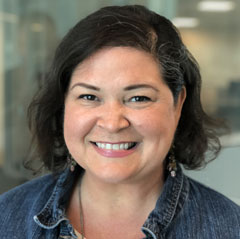Professor Karen Schmahl Shares Her Insight After Decades in Engineering

Jun 11, 2019, 9:00 AM.
Society of Women Engineers member Karen Schmahl, Ph.D., P.E., is focused on making online engineering programs engaging for students at FIU.
Q: How are you tied to SWE?
I was the first female in engineering on faculty at Miami University in Ohio back in the 1990s and became the advisor for the student SWE chapter. The chapter focused on community outreach and we bridged SWE, the Girl Scouts and the university to create an engineering day for girls, which is still running to this day. As a SWE member, I’ve presented papers at the annual conference. When I took the position at Florida International University six years ago, I was glad to see the FIU SWE student chapter is also very active in outreach activities.
Q: What motivates you?
My biggest motivation in teaching is my students. I love hearing back from them when they tell me that although my classes were very challenging they really learned useful material that they are able to apply in their current careers.
I am also still motivated to spread the word about engineering to young people, especially girls. I feel strongly, that at the 5th to 6th grade level, girls (and boys) start deciding if they like math or science. Math books don’t explain that engineering is used to solve problems. From the 1970s to late 1990s the proportion of women in medicine went up to about the 50 percent range and stayed there. In engineering, the proportion of women increased to the 20 to 25 percent range and remains there today. This is why I feel so strongly about raising awareness of the field.
Q: Did you know about SWE when you were in college?
I did, but back then, I didn’t join SWE immediately. I thought, I’m an engineer—not a woman engineer! It wasn’t until later that I saw the value of having support from an organization like SWE.
Q: Who or what were your biggest influences?
I think my earliest influences came from my parents who recognized my strengths in math and science and encouraged my study in engineering.
Q: Why do you think women decide to go into engineering?
Some of the research I read several years ago indicated that most young women went into engineering because someone significant in their life encouraged them to do so. For me, it was my mom. The way that I explained it to my daughters is that engineers use math and science to solve problems and help people. Since my younger daughter enjoyed her math and science classes she became an engineer.
Q: What made you decide to teach?
When I was working on my master’s degree, I had the opportunity to teach and realized I enjoyed figuring out how to help students understand complex problems. I also enjoyed hearing about professors’ real-world engineering experiences, so I spent time in the industry before pursuing my Ph.D. and going into academics.
Q: When did you start teaching college-level engineering courses online?
In 2000, I developed some of the early techniques in interactive online lectures. I enjoyed the challenge of coming up with ways to make my online classes more engaging for students.
Q: What do you bring to FIU’s online engineering courses?
With my industry experience in both quality management/engineering and engineering economic analysis, my students can see how my courses relate to the “real world.”
Q: Which do you like better, online or face-to-face teaching?
I am just as excited about teaching online as I am about teaching in person, and on making the classes engaging. I appreciate that online programs allow students more access to earn engineering degrees.
Q: Do you think things are different now in engineering for women?
There’s now a good sprinkling of women as professors and it is no longer unusual for women to be in professional engineering roles. Even though there are more role models for girls, we still need more engineering awareness. There are still some challenges out there, but I don’t think there are as many challenges as there used to be. There’s nothing that can really hold you back except yourself.
